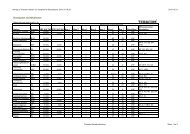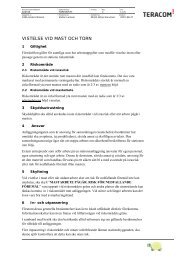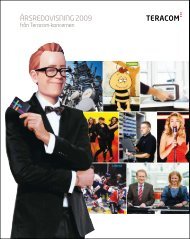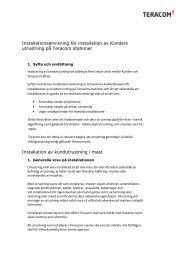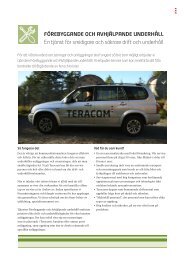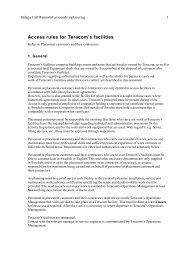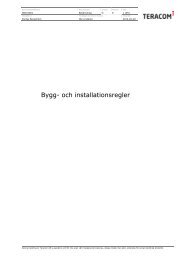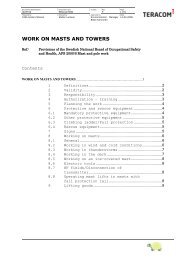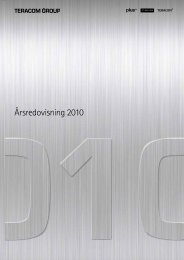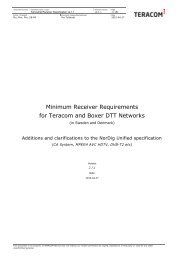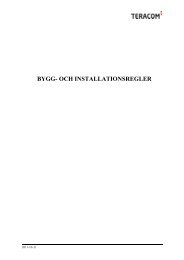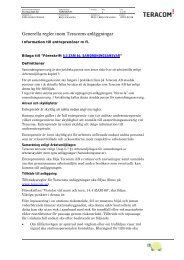Annual and Sustainability Report 2011 - Teracom
Annual and Sustainability Report 2011 - Teracom
Annual and Sustainability Report 2011 - Teracom
You also want an ePaper? Increase the reach of your titles
YUMPU automatically turns print PDFs into web optimized ePapers that Google loves.
Note 19. Inventories<br />
Group<br />
Type of goods <strong>2011</strong> 2010<br />
Finished goods 67 25<br />
Total 67 25<br />
Inventories are valued at cost. The cost for inventories that is expensed is<br />
included in the item Material costs <strong>and</strong> amounted to SEK 144 (141) million for<br />
the Group. The obsolescence reserve is included in the value of the inventories.<br />
The total write-down amount for the year was SEK 0 (0) million.<br />
Note 20. Accounts receivable<br />
<strong>2011</strong> 2010<br />
Accounts receivable 353 306<br />
Provisions for bad debts -32 -11<br />
Accounts receivable, net 321 295<br />
Provisions in relation to accounts receivable 9% 4%<br />
As of 31 December <strong>2011</strong> the Group's provision for doubtful debts was SEK<br />
32 (11) million. Group companies with pay TV operations, which have end<br />
consumers as part of their customer base, make provisions in accordance with<br />
a pre-determined ladder that has been adapted to the conditions of each geographic<br />
market. Group companies with network activities, whose customers<br />
are companies, make provisions based on an individual assessment of each<br />
customer <strong>and</strong> receivable. Provisions <strong>and</strong> the utilization of reserves for doubtful<br />
receivables were transferred to the income statement <strong>and</strong> are included in<br />
cost of sales.<br />
The carrying amount of accounts receivable is the same as the fair value since<br />
the discounting effect is insignificant. The fair value of accounts receivable<br />
constitutes maximum exposure to the calculated risk for bad debt losses.<br />
The credit terms for various types of contracts <strong>and</strong> customer categories are<br />
defined in each subsidiary's credit instructions. A credit statement is obtained<br />
for sales on credit to both companies <strong>and</strong> consumers in order to minimize the<br />
risk of bad debt losses.<br />
Time analysis of accounts receivable fallen due <strong>2011</strong> 2010<br />
Accounts receivable that have not fallen due 215 188<br />
Accounts receivable overdue < 30 days 87 94<br />
Accounts receivable overdue 30 - 60 days 10 6<br />
Accounts receivable overdue 61 - 90 days 4 2<br />
Accounts receivable overdue 91 - 120 days 2 2<br />
Accounts receivable overdue > 121 days 3 3<br />
Accounts receivable, total 321 295<br />
Provisions for doubtful receivables <strong>2011</strong> 2010<br />
Provisions 1 January -11 -24<br />
New provisions -16 0<br />
Release of reserves 4 11<br />
Bad debt losses -9 2<br />
Exchange rate differences <strong>and</strong> other changes 0 0<br />
Provisions 31 December -32 -11<br />
Note 21. Financial instruments <strong>and</strong> financial risk management<br />
<strong>Teracom</strong>’s operations expose the Group to various types of financial risk. The<br />
Group’s overall financial operations <strong>and</strong> management of financial risk are<br />
centralized to the <strong>Teracom</strong> Group's Finance department. These activities are<br />
based upon the finance policy established by the Board of Directors, which is<br />
characterized by the desire to maintain a low level of risk. The Group's financial<br />
strategy <strong>and</strong> goals are designed to achieve maximum return on equity<br />
based upon reliable, cost-effective financial management practices that help<br />
ensure adequate control <strong>and</strong> high quality risk management within the Group.<br />
The overriding principle is to minimize all factors that could have a negative<br />
impact on earnings <strong>and</strong> cash flow due to short-term fluctuations in financial<br />
markets. This applies to both the Parent Company <strong>and</strong> the Group, in its entirety.<br />
The Group may use derivative instruments in order to hedge certain exposures<br />
to risk, however, only for the following purposes:<br />
- To convert future payments for electricity consumption to a fixed electricity price.<br />
- To convert future expected commercial payments in foreign currencies (primarily<br />
EUR) to Swedish krona (SEK).<br />
- To convert the fixed interest term for borrowing.<br />
- To hedge net investment in foreign operations.<br />
The market risks include currency risk, interest rate risk <strong>and</strong> electricity price<br />
risk, which are also described in this note. Other financial risks are broken<br />
down into credit risk, liquidity risk <strong>and</strong> financing risk.<br />
Currency risk<br />
This is the risk that changes in exchange rates will negatively impact the<br />
Group's profitability or financial position. This type of risk is divided into two<br />
categories (below): transactional <strong>and</strong> translational.<br />
Transactional exposure<br />
Transaction exposure encompasses all future contractual <strong>and</strong> forecasted<br />
income <strong>and</strong> expenses in foreign currencies, which thus involve a risk that the<br />
Group's profitability will be negatively impacted by changes in exchange rates.<br />
The <strong>Teracom</strong> Group has limited transactional exposure. This is because the<br />
value-added from international business activities is primarily created locally<br />
by having expenses in the same currency as the sales revenues.<br />
Currency derivatives are used to decrease transaction exposure in EUR <strong>and</strong><br />
the hedged flow on the balance sheet date was EUR 6 million.<br />
Sensitivity analysis of currency risk<br />
The <strong>Teracom</strong> Group's currency transactions are primarily in SEK, EUR <strong>and</strong> DKK.<br />
During <strong>2011</strong>, the net outflow of EUR amounted to the equivalent of SEK -148<br />
(-146) million. In <strong>2011</strong>, the average exchange rate for EUR was SEK 9.0335. A<br />
fluctuation in the exchange rate of +/- 10 percent would impact profits by<br />
SEK +/- 15 million. The Group's net flow in DKK during <strong>2011</strong> was close to zero<br />
through internal currency netting within the Group.<br />
Translational exposure<br />
Because the company has international business activities, there is also a<br />
certain degree of translation exposure. This is rooted in the value of foreign<br />
investments as well as the profits generated on an ongoing basis. Such profits<br />
are translated using the average rate for the year as the opening value <strong>and</strong><br />
comparing it to the year's ending rate, which is provided by the Swedish Central<br />
Bank. The difference is reported against equity. Accordingly, the only time<br />
that an actual cash flow is involved is in connection with disposals, investments<br />
<strong>and</strong> dividends from subsidiaries.<br />
84



